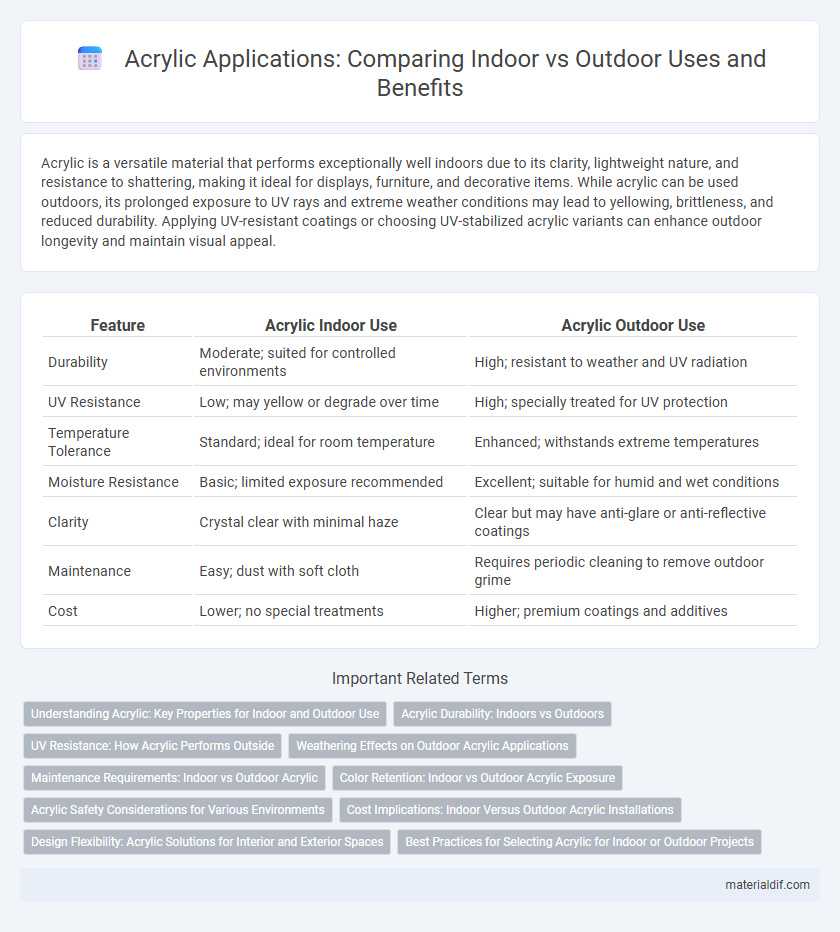Acrylic is a versatile material that performs exceptionally well indoors due to its clarity, lightweight nature, and resistance to shattering, making it ideal for displays, furniture, and decorative items. While acrylic can be used outdoors, its prolonged exposure to UV rays and extreme weather conditions may lead to yellowing, brittleness, and reduced durability. Applying UV-resistant coatings or choosing UV-stabilized acrylic variants can enhance outdoor longevity and maintain visual appeal.
Table of Comparison
| Feature | Acrylic Indoor Use | Acrylic Outdoor Use |
|---|---|---|
| Durability | Moderate; suited for controlled environments | High; resistant to weather and UV radiation |
| UV Resistance | Low; may yellow or degrade over time | High; specially treated for UV protection |
| Temperature Tolerance | Standard; ideal for room temperature | Enhanced; withstands extreme temperatures |
| Moisture Resistance | Basic; limited exposure recommended | Excellent; suitable for humid and wet conditions |
| Clarity | Crystal clear with minimal haze | Clear but may have anti-glare or anti-reflective coatings |
| Maintenance | Easy; dust with soft cloth | Requires periodic cleaning to remove outdoor grime |
| Cost | Lower; no special treatments | Higher; premium coatings and additives |
Understanding Acrylic: Key Properties for Indoor and Outdoor Use
Acrylic offers excellent clarity and UV resistance, making it ideal for outdoor use where exposure to sunlight and weather is frequent. Its moisture resistance and durability also suit indoor applications such as displays, furniture, and signage, providing a shatter-resistant alternative to glass. Understanding acrylic's resistance to yellowing and impact strength is crucial when selecting it for either indoor or outdoor environments.
Acrylic Durability: Indoors vs Outdoors
Acrylic's durability indoors remains high due to its resistance to yellowing and impact, maintaining clarity and strength in controlled environments. Outdoors, however, prolonged exposure to UV rays and weather elements can cause degradation, including surface crazing and color fading. UV-resistant coatings or additives enhance acrylic's outdoor lifespan, yet indoor use generally guarantees longer material integrity.
UV Resistance: How Acrylic Performs Outside
Acrylic exhibits excellent UV resistance, making it highly durable for outdoor use without yellowing or becoming brittle over time. Indoor acrylic benefits from its clarity and scratch resistance but faces fewer environmental stressors compared to outdoor applications. UV-stabilized acrylic formulations enhance longevity and maintain optical clarity when exposed to sunlight and weather elements.
Weathering Effects on Outdoor Acrylic Applications
Acrylic used outdoors undergoes significant weathering effects such as UV radiation exposure, temperature fluctuations, and moisture, which can cause discoloration, brittleness, and surface degradation over time. Indoor acrylic remains stable with minimal exposure to harmful elements, preserving clarity and strength for extended periods. Specialized UV-resistant coatings and formulations improve the durability of outdoor acrylic, enhancing its resistance to fading and cracking.
Maintenance Requirements: Indoor vs Outdoor Acrylic
Indoor acrylic requires minimal maintenance due to its protection from harsh weather conditions, resulting in less frequent cleaning and no need for UV-resistant coatings. Outdoor acrylic demands regular cleaning to prevent dirt buildup and exposure to UV rays, which can cause discoloration and brittleness without protective treatments. Using UV-resistant finishes and scheduling consistent inspections prolongs outdoor acrylic's durability and appearance.
Color Retention: Indoor vs Outdoor Acrylic Exposure
Acrylic used indoors retains its vibrant color longer due to limited exposure to UV rays, moisture, and temperature fluctuations, which reduces fading and yellowing. Outdoor acrylic must be treated with UV inhibitors and weather-resistant coatings to maintain color stability against sun exposure and harsh environmental conditions. Indoor acrylic typically exhibits superior color retention over time compared to outdoor acrylic subjected to continuous environmental stress.
Acrylic Safety Considerations for Various Environments
Acrylic's safety for indoor use relies on its low toxicity, shatter resistance, and UV stability, making it ideal for household items and interior decor. For outdoor applications, acrylic must feature enhanced UV inhibitors and weatherproof coatings to prevent brittleness, discoloration, and degradation from prolonged sun exposure. Ensuring proper ventilation indoors and selecting UV-stabilized formulations outdoors optimizes acrylic's durability while minimizing health and safety risks.
Cost Implications: Indoor Versus Outdoor Acrylic Installations
Indoor acrylic installations generally incur lower costs due to reduced exposure to UV rays and harsh weather, minimizing the need for frequent maintenance or replacement. Outdoor acrylic, designed with UV inhibitors and weather-resistant additives, typically commands a higher initial investment to ensure durability and longevity. Long-term expenses for outdoor applications can escalate if cheaper, less durable acrylic is used, as it may yellow, crack, or degrade faster under environmental stress.
Design Flexibility: Acrylic Solutions for Interior and Exterior Spaces
Acrylic offers exceptional design flexibility for both indoor and outdoor applications, adapting seamlessly to diverse aesthetic and functional requirements. Its versatility allows for custom shapes, colors, and finishes that enhance interior decor while withstanding outdoor elements like UV exposure and moisture. This durability, combined with ease of fabrication, makes acrylic an ideal solution for innovative design across residential, commercial, and public spaces.
Best Practices for Selecting Acrylic for Indoor or Outdoor Projects
Selecting acrylic for indoor projects prioritizes clarity, UV resistance, and scratch resistance, ensuring long-lasting aesthetics under controlled conditions. For outdoor use, choosing UV-stabilized, weather-resistant acrylic variants prevents yellowing, cracking, and degradation from sun exposure and temperature fluctuations. Proper thickness and protective coatings enhance durability and maintain performance in both indoor and outdoor environments.
Acrylic Indoor Use vs Outdoor Use Infographic

 materialdif.com
materialdif.com